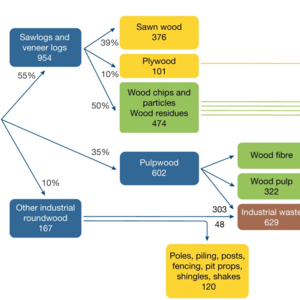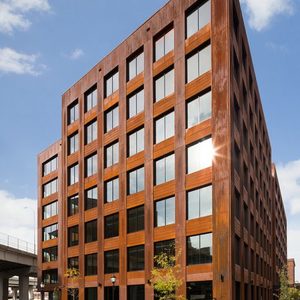
Is mass timber a climate panacea? This question has become one for the ages, or at least, for this particular age. And despite numerous advances in manufacturing and sustainable forestry, the answer to this query remains the same: to be determined.
The mass-timber construction industry has grown adept at marketing its sustainability bona fides, touting everything from associated biophilic properties and advancements in seismic resistance to estimated carbon savings—including avoided emissions and carbon storage—per each square meter of floor space. Such efforts have paid dividends. As of June of 2023, there were 1860 recorded mass-timber projects built or in progress in the U.S. alone, according to the non-profit WoodWorks. This represents exponential growth over at least the last decade.
Tall timber is also trending. Thanks to new construction codes in the 2021 International Building Code (and refinements in the 2024 IBC), viable pathways to constructing towers of a dozen or more stories, typically composed of cross-laminated timber (CLT) panels and glulam beams, are no longer hard to come by. Insurers are getting on board as well, clearly convinced that such buildings will perform as advertised.
Australia, Canada, and the U.S. are all ascending forces in this market category, but its epicenter remains in Europe. Of the 20 tallest mass-timber buildings across the globe, 13 of them are in Western and Central Europe and Scandinavia, where projects largely benefit from responsible forest management and regional manufacturing. (Lumber production in Central Europe recently experienced a slight decline due to a bark beetle infestation in the Czech Republic and Germany, which peaked in 2019, and Russia’s invasion of Ukraine, which has put a halt to forest product imports from Russia and Belarus.) Of course, these are all standalone projects, each one a singular edifice that is being leveraged, to varying degrees of success, as one more victory in the crusade against global warming. But as wiser minds have previously asserted, “we can’t build our way out of the climate crisis.” Or can we?
A city made of wood
In the Swedish city of Sickla, just south of Stockholm, the urban developer Atrium Ljungberg announced its plans last summer to build an entire neighborhood made from wood. Appropriately dubbed Stockholm Wood City, the development’s scope will include 32 buildings spread throughout 25 blocks, and comprise approximately 250,000 square meters (~2.7 million square feet) of gross floor area devoted to residential, offices, schools, and retail. The estimated tally includes 2000 new homes and 7000 new office spaces. The project is expected to break ground in 2025, with the first buildings ready for occupancy by 2027.
Atrium Ljungberg’s business developer in Sickla, Håkan Hyllengren, confides that throughout the projected course of building out the entire neighborhood, which he estimates at 10 years, calculating the precise cumulative carbon savings isn’t feasible. From there Hyllengren pivots, comparing the development’s use of timber versus concrete and steel options. “On average, the calculations tell us we can reduce our carbon footprint in the production phase by about 40 percent,” he says, which will prove critical to getting his company to its stated goal of carbon neutrality by 2030.
As for its ledger, Hyllengren doesn’t claim cost parity between timber and steel or concrete products of equal measure, but he does see a not-too-distant future where things break even. “We estimated the cost of using timber instead of steel or concrete will be the same. Alright, [timber is] a little bit more pricey, but the total yield on the project will be the same because we will build it faster, so we can rent faster, and shorter production times will also reduce the cost even if the material is a bit more expensive. On the whole, if you look on the total production cost, it’s equal.”
Like every other mass timber project in Europe, the materials supply chain is a regional matter. In the case of Stockholm Wood City, Atrium Ljungberg’s leadership confirms that “most of the lumber” used for the CLT that will comprise this neighborhood will be sourced and manufactured within Sweden, with possible remainder amounts coming from Finland next door. Sweden has the largest forest area among all EU countries, with about 28 million hectares, but also one of the lowest employment rates per area of forest. “I think we’re exporting about 70 percent of what we produce each year. If we can use more of it in Sweden, that’s good. And we have a sufficient amount of wood in Sweden to build houses,” Hyllengren says.
Mass timber meets the five-minute city
For Stockholm Wood City to live up to its hype, it will have to promise far more than a 40% reduction in embodied emissions relative to steel and concrete. And it will have to bill itself as more than an “ambitious sustainability project” that benefits “people’s health and well-being.” In the mass timber game, that’s old hat. For this project to matter, its impacts will need to span generations.
Atrium Ljungberg has made the redevelopment of Sickla—formerly an industrial area of mid-rise factories and modest brick homes—a cornerstone of its business model. The mostly undeveloped parcel of land that Stockholm Wood City will eventually occupy has been on the company’s books since 1997. But the infrastructure that will feed into this new development is already largely in place. High- and medium-density development, which includes existing offices, homes, schools, healthcare, cultural facilities, hotels, and access to nature, has already yielded what the developer calls a “5-minute city” (a clever bit of one-upmanship on the popular 15-Minute City concept), where everything one could need is conceivably just a five-minute walk away.
While Stockholm Wood City doesn’t yet have a master plan or even the necessary zoning approvals to move forward (zoning planning is currently ongoing at select sites, according to Hyllengren), the larger design and development team doesn’t appear concerned. Danish architecture firm Henning Larsen and Swedish firm White Arkitekter are collaborating on the broader design scope that will include buildings with green roofs, PV arrays, and large high-performance windows. Additionally, the proposed neighborhood will further “minimize its climate impact” with the use of “internally produced, stored, and shared energy” and “underground borehole energy storage for heating and cooling.” (Translation: a district energy system and geothermal heat pumps.)
But any 15-Minute City (or 5) can never truly be so without robust public transit. Currently, a tram line and railroad already connect to the area, and an expansion of the Stockholm Metro is planned for Sickla by 2030. “So, there will be three different public transport options for this area,” Hyllengren says. He adds, “We are working hard to reduce the uses of cars to the area. Our focus is on services and safety, having a good mixture of offices and residential and culture, all the things that make a livable city.”
In light of this proposed urban development, for which there really is no precedent, skeptics will – and should – take its stakeholders to task. After all, building anything big and new and calling it the solution to our woes (or at least part of the solution) is about as brazen a gesture there is. But build anew we must, to varying degrees, and if we must, then let us do so on a scale that both minimizes the long-term impacts of manufacturing and construction as well as services as many people as possible in a manner that is clean, efficient, and equitable.
Indeed, we can’t build our way out of the climate crisis. But something as grand as Stockholm Wood City can, in theory, provide a new kind of foundation for sustainable development and urbanization on which future innovators may design said solutions. It’s not a panacea, but it’s also far from nothing.
________________________________________________________________________
Justin R. Wolf is a Maine-based writer who covers green building trends and energy policy.
Weekly Newsletter
Get building science and energy efficiency advice, plus special offers, in your inbox.














8 Comments
The reoccurring pr0blem I see with renderings of mass timber buildings is architect's desire to express the wood structure by bringing it outside the building enclosure as a design element. Wood is good at a lot of things, but being exposed to UV and moisture isn't one of them.
True. I would hope that any wood visible on the outside is simply a finish material and not a part of the actual structure. That way it could be replaced as necessary over time without disruption or unreasonable expense. From a sustainability standpoint wood is certainly preferable to common commercial finish materials such as aluminum.
Traditional wood structures in Europe typically had such layered systems, with charming, decorative wood elements that faced the weather and could easily be replaced, protecting the primary wood structure.
Plenty of buildings with wood siding. Why is CLT any different? Paint it, stain it, coat it with something transparent, it's simply not an issue. But first and foremost, don't read too much into digital renderings.
xenomorph,
CLT is fundamentally different than siding for a variety of reasons, the most important being that cladding can continue to function fairly well even when compromised, and being structural the consequences of CLT failing can be catastrophic. Manufacturers of CLT acknowledge this in that none of their products are designed to be exposed without an additional layer of protection.
Cladding on walls and roofs has a lifecycle which is understood to include periodic replacement. Do we really want to start having the load-bearing structure of buildings similarly short-lived?
The searching
What is the advantage of mass timber over 2x stud/joist framing or a beefier version of the same for larger footprints?
From a structural standpoint it looks to me like an inefficient use of material. A combination of heavy timber structure and 2x infill walls could easily be made to work for buildings up to 8 stories, maybe more. Fire protection and acoustics are easily solved as well.
As an aside, maybe I'm misunderstanding the phrase "mass timber". I understand it to be something distinct from "heavy timber". The mass timber buildings I've seen here in Europe are not made up of discrete posts and joists. They are wall sized panels, or similar solid laminated panels used for floors. It's a panelized system with solid components.
JGSG,
Mass timber is used to describe any structural system where the main load-bearing elements are engineered wood products, whether they incorporate panellized components or not. The term is a bit of a catchall, much like Tiny Houses, which can be either site-built RVs, or simply small dwellings on foundations.
Mass Timber more closely mimics the structures you typically see made from concrete or steel, allowing the longer spans of commercial buildings, and has point loads, rather than load-bearing walls. One big advantage is adaptability. Concrete slab office high-rises have proved very difficult to change uses when demand softens. https://www.dezeen.com/2023/11/23/nbbj-concept-modular-mass-timber-lab-building/
The functional height limit of stick frame construction appears to be five stories - and I'm seeing a few of those go up round me here. Above that the stud spacing is too close, you get into problems of differential settlement on things like elevators. and can't transfer the larger vertical loads due to wall thickness. Mass Timber also has a comparable fire resistance to steel structures, which stick framing lacks.
What a heelll?
Log in or create an account to post a comment.
Sign up Log in